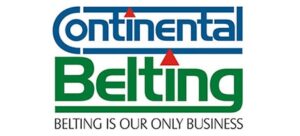Belting Glossary - Conveyor Belt Terms and Meanings
There are currently 52 names in this directory beginning with the letter P.
Permanent set
The amount by which an elastic material fails to return to its original form after deformation.
Permeability
The quality or condition of allowing passage of liquids or gases through a rubber layer.
Pitch line
The plane within a belt which undergoes neither stretching nor compression when the belt rounds the pulley, i.e., the neutral plane of the belt structure.
Plain weave
The simplest type of weave with both adjacent warp and filling yarns crossing over and under each other.
Plastic
A material that contains as an essential ingredient one or more organic polymeric substances of large molecular weight, is solid in its finished state, can be shaped by flow.
Plasticizer
A compounding ingredient which can change the physical and chemical properties and processibility of a polymeric compound.
Ply adhesion
The force required to separate two adjoining strength reinforcing members in a rubber product.
Polymer
A macromolecular material formed by the chemical combination of monomers having either the same or different chemical composition.
Portable vulcanizer
A vulcanizer readily moved from one place to another, usually used for making field splices and repairs.
Pot life
The period of time during which a reacting polymeric compound remains suitable for its intended use after having been mixed with a reaction-initiating agent.
Powered roller conveyor
A term used by the U.S. Postal Service to mean a live roller conveyor. See live roller conveyor.
Press
A machine consisting of two or more heated plates which can be brought together and separated by hydraulic pressure or mechanical action.
Press marks
Irregularities in the surface of a vulcanized product caused by the press ends or by corresponding irregularities in the press surface.
Pricker marks
Small marks in the cover of a vulcanized belt where a roll with sharp needles had penetrated the uncured belt to allow trapped air in the uncured belt composite to escape.
Profile top cover
Belt surface having a series of continuous or interrupted, straight or curved ridges, across the belt at regular intervals to enhance the belts ability to move materials up inclines or down declines.
